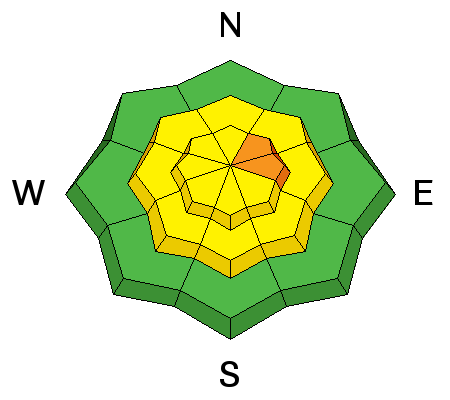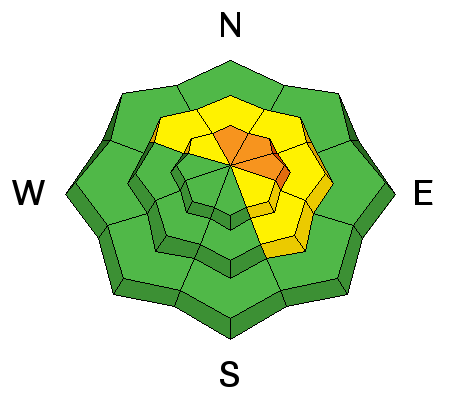25th Annual Black Diamond Fall Fundraising Party
Thursday, September 13; 6:00-10:00 PM; Black Diamond Parking Lot

25th Annual Black Diamond Fall Fundraising Party
Thursday, September 13; 6:00-10:00 PM; Black Diamond Parking Lot
| Advisory: Ogden Area Mountains | Issued by Evelyn Lees for Thursday - March 1, 2018 - 7:01am |
|---|
 |
special announcement To get help in an emergency (to request a rescue) in the Wasatch, call 911. Be prepared to give your GPS coordinates or the run name. If you trigger an avalanche in the backcountry, but no one is hurt and you do not need assistance, please notify the nearest ski area dispatch to avoid a needless response by rescue teams. Thanks.
|
 |
current conditions Yesterday’s bluebird day has morphed into a graybird day…skies are mostly cloudy this morning and the southerly winds increasing. Mid elevation wind speeds are averaging 10 to 15 mph; but the high Ogden ridgelines have already had averages of 25 to 40 mph, with gusts to 45. Temperatures are warm, in the teens and twenties, with a temperature inversion making the trailheads slightly cooler. Soft dense powder remains on sheltered, shady slopes, amidst the wind slabs and crusted sunny slopes. Snotel snow depths are now: Ben Lomond peak - 52”, Ben Lomond trailhead - 22”. Farmington and Monte Cristo have around 52” of snow on the ground. |
 |
recent activity Yesterday, 2 seperate slides were triggered in Hells Canyon, both at 8500', on northerly facing slopes, and running 2000' verticle feet down into the gully bottom. Luckily, noone was caught in these slides. One soft slab was triggered remotely, 100' wide by 2 feet deep. The other was triggered by a snowboarder, 40 feet wide by 18" deep. Both failed on facets. The second slide was not reported, so not knowing if someone was caught, a dangerous search was completed by the Snowbasin ski patrol that proved needless. Snowpit tests on other upper elevation, northerly facing slopes continue to show poor structure, with full propegation on faceted weak layers, and collapsing. Slides were also triggered with explosives along high ridge lines. Snowboard triggered slide, Hells Canyon. Snowbasin patrol.
Debris from the Hells Canyon slide. Snowbasin patrol.
|
| type | aspect/elevation | characteristics |
|---|


|


|

LIKELIHOOD
 LIKELY
UNLIKELY
SIZE
 LARGE
SMALL
TREND
 INCREASING DANGER
SAME
DECREASING DANGER
|
|
description
New wind slabs will be created by today’s increasingly strong southerly winds, easy to trigger. They will be loaded on top of Monday’s pencil hard wind slabs, which are along ridge lines and scattered in open bowls and the mid elevations. The older, hard wind slabs are stubborn, but can still be triggered by a person, and be anywhere from a few inches to two feet deep. Hard slabs are different – they almost always break above you, and often on the second or third person. Cornices are becoming more widespread along ridgelines – continuing to grow with today’s increasing southerly winds. Cornices often break back further than expected, on to what looks like flat terrain. So give them a wide berth and avoid travel below them. Left - hard slab diagram – read more about them here.
|
| type | aspect/elevation | characteristics |
|---|


|


|

LIKELIHOOD
 LIKELY
UNLIKELY
SIZE
 LARGE
SMALL
TREND
 INCREASING DANGER
SAME
DECREASING DANGER
|
|
description
Avalanches triggered yesterday on buried layers of faceted snow on steep slopes show dangerous conditions exist in the Ogden area mountains. Many slopes have poor structure – soft sugary, weak layers, both mid-pack and near the ground. It seems some of the steep slopes are just waiting for a trigger – and which slopes will slide are unpredictable - though slopes facing northerly through easterly are the most likely places to trigger a slide and should be avoided, especially in continuously steep terrain or slopes with terrain such as gullies, trees or cliff bands. Cracking and collapsing are bulls-eye clues to instability, but these clues may not be present, and snow pit tests could be unreliable. |
 |
weather A weak disturbance crossing northern Utah will increase the winds and produce an inch or two of snow this afternoon. Mostly cloudy skies today, with the southerly winds slowly increasing throughout the day. By evening, mid elevations ridge lines could average 25 mph with gusts to 30 mph, and the high elevations average 45 mph, gusting in the 50s. By morning, winds will be very strong. Temperatures will warm into the mid 20s to low 30s. The next storm continues to look good, though slowing down – it will be preceded by strong winds starting after midnight and continuing all day Friday. The main cold front should arrive Saturday with periods of snow, heavy at times, continuing into Sunday. We are still hoping for one to two feet of snow at the higher elevations |
| general announcements CLICK HERE FOR MORE GENERAL INFO AND FAQ The UAC has new support programs with Outdoor Research and Darn Tough. Support the UAC through your daily shopping. When you shop at Smith's, or online at Outdoor Research, REI, Backcountry.com, Darn Tough, Patagonia, NRS, Amazon, eBay a portion of your purchase will be donated to the FUAC. See our Donate Page for more details on how you can support the UAC when you shop. Benefit the Utah Avalanche Center when you buy or sell on eBay - set the Utah Avalanche Center as a favorite non-profit in your eBay account here and click on eBay gives when you buy or sell. You can choose to have your seller fees donated to the UAC, which doesn't cost you a penny This information does not apply to developed ski areas or highways where avalanche control is normally done. This advisory is from the U.S.D.A. Forest Service, which is solely responsible for its content. This advisory describes general avalanche conditions and local variations always occur. |